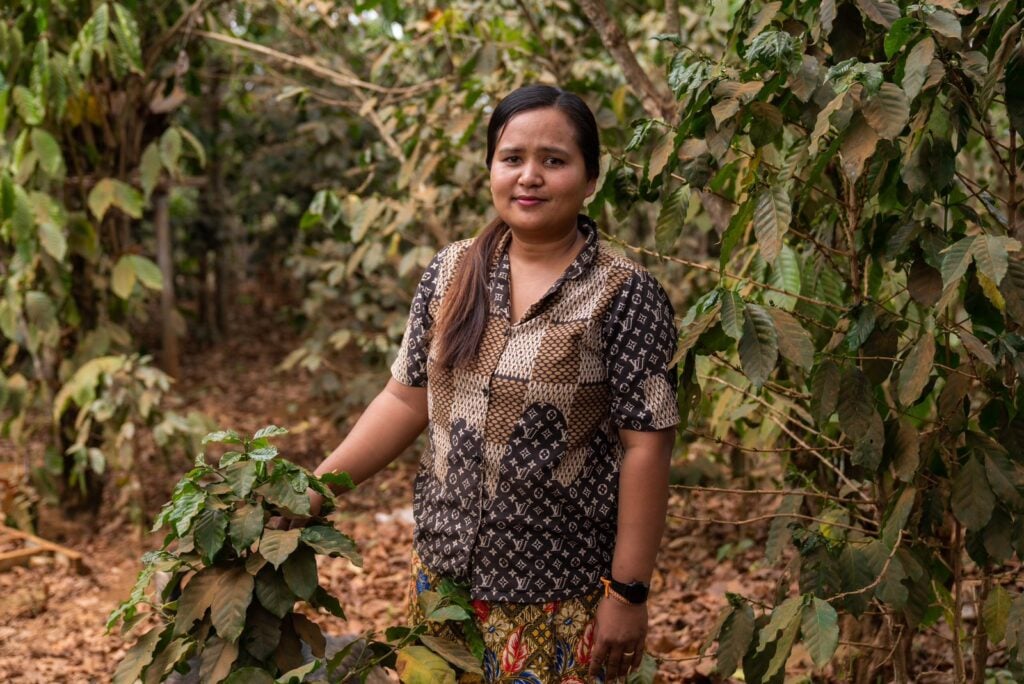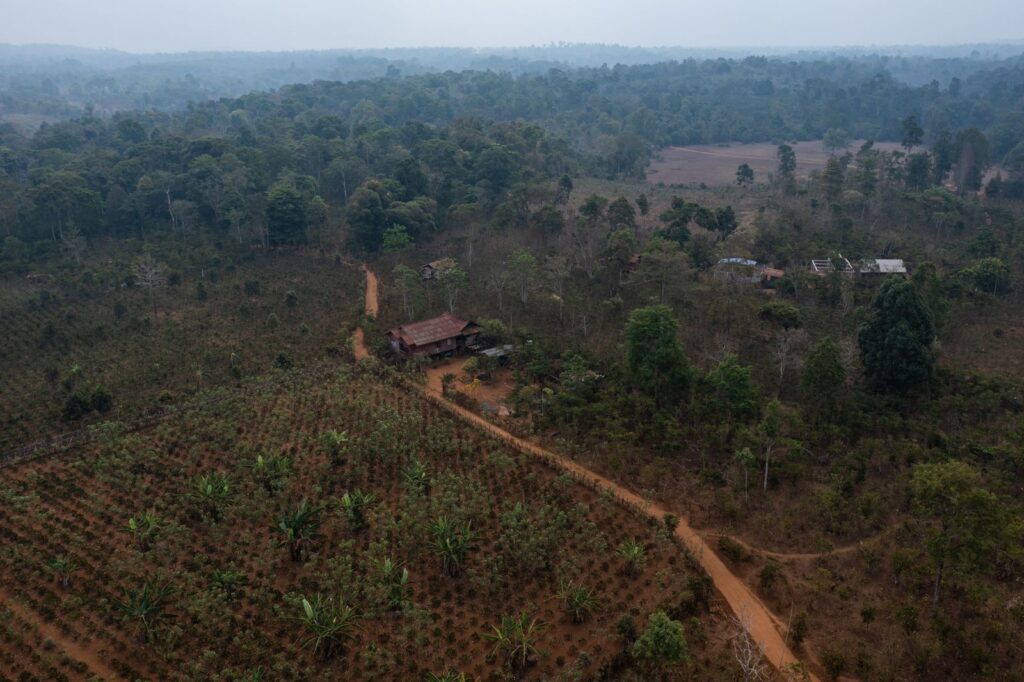SALAVAN, LAOS – Coffee has been the primary source of income that has helped lift many Lao farmers out of poverty. However, this progress has been threatened by an increase in extreme weather events that have led to unstable coffee production and a decline in output.
Coffee farmer Pheuy Thavisak, 33, has been surrounded by coffee plantations since she was born in Lao Nga village of Laos’ southern Bolaven Plateau – an area known for its superior flavored coffee beans.
She dropped out of primary school because her parents did not think it was beneficial for girls to get an education.
Tradition dictated that her future was at home, tending to children, rather than attending classrooms.

But thanks to the growing number of coffee lovers worldwide, Pheuy and her family have been able to earn decent livelihoods from the coffee business, despite her not attending classes.
She developed a love for her fertile land while working in the field all her life, but this love has turned to worry due to the accelerating impacts of climate change.
“After the harvest in February, the rains were scarce,” lamented Pheuy. “I fear next year’s harvest will fall even shorter.”
Lao Nga village comprises 227 families who rely heavily on coffee cultivation. These families farm a combined area of approximately 800 hectares.
Influenced by extreme El Niño weather patterns, drought and heatwaves in the first half of this year slashed Pheuy’s coffee harvest down to 1.5 tons per hectare, a decrease from 2.2 tons last year. This reduction means a significant loss in her family’s income.
Although the rain recently arrived in Laos, the loss from the first half of the year is unlikely to be compensated by the next coffee production round – which will likely face abnormally heavy rain due to a swing back to La Niña conditions later this year, according to the World Meteorological Organization’s forecast.

While the impact of climate change on El Niño and La Niña is subject to further research, a 2020 publication by the American Geophysical Union raised the possibility that global warming will increase the frequency of extreme events associated with both weather patterns.
Another recent study suggested that the effects of El Niño in Southeast Asia will intensify under global warming, due to abnormal sea-surface temperatures in the Pacific Ocean.
This threat will likely hold back Laos’ progress in reducing poverty and food security, according to a World Bank’s report. Coffee farmers will be among those affected the most.
Decline in production
The Bolaven Plateau is Laos’ vital coffee production hub, spanning across three southern provinces – Salavan, Champassak and Sekong. The area is well known for its diverse ethnic groups and the cultivation of high temperature-sensitive Arabica coffee.
An analysis by a researcher at the National University of Laos pointed out that about 1,855 farming households grow coffee on the Bolaven Plateau. In 2021, coffee plantations covered approximately 83,320 hectares, making it the fourth most planted crop after rice, maize and vegetables.
Laos exports about 30,000 tons of coffee annually, primarily to neighboring countries like Vietnam, Thailand and Cambodia, as well as to European countries and Japan.
However, the impact of extreme weather is undermining Laos’ ability to maintain or increase its production levels.
The World Bank’s 2019 report highlighted that Laos had experienced 38 extreme climate events since 1996, causing US$625 million in damages.
Approximately 71% of these events occurred during El Niño or La Niña years, leading to devastating floods or droughts. The same study also found that a typical El Niño event caused “modest losses” to Laos’ GDP, while a La Niña caused “modest gains”, but not enough to fully negate the effects of El Niño.

The impact of extreme weather events is exacerbated by inflation in Laos, which has led to higher production costs for coffee farmers.
A news report this year indicated that smallholder coffee farmers have faced a shortage of workers due to high inflation, creating difficulties for coffee businesses that require intensive labor in the fields.
Sivixay Xayyaseng, Head of the Lao Coffee Association, reported a continued decline in coffee exports from the Bolaven Plateau.
Last year, growers exported about 24,700 tons of coffee, generating nearly $60 million in revenue. This represented a decrease from previous years, with 24,985 tons exported in 2022, 30,000 tons in 2021 and 35,000 tons in 2020.
“Exports of plateau coffee have plummeted,” confirmed Sivixay. “Drought, extreme heat and disease have ravaged the plantations. Many farmers have shifted to crops like cassava for quicker harvests and cash.”
This switch, however, comes at a cost, as forest trees have been cleared to make way for cassava fields.
Khamtun Seevongsa, head of the Santiphab Coffee Producer Group, said coffee growers were increasingly turning to chemical fertilizers in an attempt to boost yields in the face of extreme weather events.
Support for farmers
According to the UNDP, Laos’ greenhouse gas emissions account for only 0.09% of the global total.
However, the University of Notre Dame Global Adaptation Initiative Index ranks Laos 121st out of 185 countries in terms of vulnerability and readiness to cope with climate change, indicating that the country is highly vulnerable.
This situation has prompted many international donors to provide funding and assistance to improve Laos’ capacity to mitigate and adapt to climate change. These efforts include enhancing the resilience of Laos’ coffee farmers and value chains to better prevent and cope with climate-related shocks.
One such initiative is a Food and Agriculture Organization project aimed at improving platforms for weather forecasting in the agricultural sector. This project provides smaller farmers with crucial information to plan their production and adapt to changing weather patterns.
The International Labor Organization is also running a project to promote labor rights and improve the livelihoods of coffee and tea farmers and workers on the Bolaven Plateau.
This project addresses various issues, including educating farmers and workers on protecting themselves from hazardous chemicals and how to collectively bargain for better coffee prices.


Women play a crucial role in the coffee supply chain as they are heavily involved in the cultivation and harvesting of coffee bean processing.
Vansy Senyavong, the Director of Women Mobilizing for Development, stated that her organization had implemented training programs to enhance gender-related skills.
These programs aim to ensure that women can make informed decisions on the farm, including when dealing with climate events.
“We engage them in drawing activities that encourage them to solve problems using their own ideas and provide solutions to family issues and ways to overcome poverty,” said Vansy.
“Women’s participation in our activities has increased significantly when they are given platforms to voice their ideas and solutions.”
“We now have a better understanding of financial planning as well as coordinating our work schedules,” said Pheuy, the coffee farmer who participated in the training activities.
“My husband lets me make the decisions. Sometimes it feels like I’m the head of this family.”
This story was produced with support from the Internews’ Earth Journalism Network and the Australian Water Partnership. It was first published by Vientiane Times and edited by the Mekong Eye editorial team for clarification.




